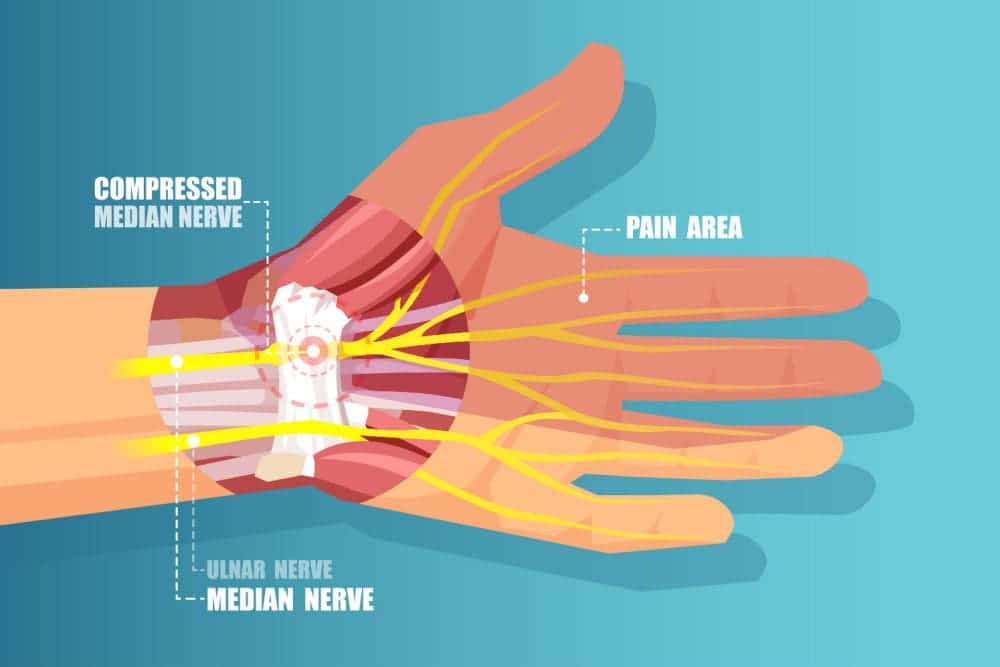Carpal Tunnel Syndrome can affect many people, with an estimate of about one to three people being affected for every 1,000 in the United States. It has been noted that women can develop carpal tunnel syndrome three times more than men, and this condition can worsen without the proper care.
Carpal tunnel syndrome can cause pain, weakness, and numbing in the hands or arms. Because carpal tunnel syndrome develops gradually, this can lead to a drastically changed quality of life for many. To understand the possible prevention of carpal tunnel syndrome, it is crucial to understand how it develops and what specific symptoms to look out for.
How Does Carpal Tunnel Syndrome Develop?

Though you may not be aware, the carpal tunnel is actually a part of the hand, known as a narrow passageway encompassed by bones and ligaments located in the palm area of the hand. Running through this passageway is the median nerve, which provides sensation to the palm side of all fingers beside the little finger and produces nerve signals to move the muscles around the base of the thumb (also known as motor function). When you start to develop carpal tunnel syndrome, it is due to pressure or irritation to the median nerve.
Issues to the median nerve can be caused by a number of things. Constant hand motions (such as constant typing on the computer or repetitive hand movements for sports), wrist anatomy, trauma or injury to the wrist such as a sprain or swelling, rheumatoid arthritis, and other health problems may contribute to the development of carpal tunnel syndrome. Because carpal tunnel syndrome can develop for many reasons, it may be hard to pinpoint what the specific reason for your case may be. Sitting down with an expert to properly be examined may be your best option.
What Signs Should I Look Out For?
Carpal tunnel syndrome can develop gradually, and many people may not even realize this is a problem until they are dealing with a number of constant and troublesome symptoms. It is extremely important to keep an eye out when it comes to signs of carpal tunnel syndrome, as acting fast and ensuring you can go back to your daily routines free of pain and numbness are keys. Signs to look out for that may point to carpal tunnel syndrome include:
- Weakness in one or both hands when gripping something
- Feelings of “pins and needles” in the fingers
- A burning or tingling sensation in the fingers, especially in the thumb and index finger
- Pain or numbness that can worse at night, leading to interrupted sleep
- Pain or numbness in both hands at any time
If you or someone you know is suffering from one or more of these debilitating symptoms, it is extremely important to get the proper care that can prevent symptoms from worsening and leading to permanent consequences. Carpal tunnel syndrome that is left untreated can result in permanent muscle and nerve damage.
Need Relief For Carpal Tunnel Syndrome?

Carpal tunnel syndrome can have a lasting impression on your day-to-day activities. Because this condition can develop gradually and lead to a variety of symptoms, it is always a good idea to get the help and prognosis of a specialist when it comes to much-needed relief from any worsening symptoms. If you are unsure whether your symptoms are those of carpal tunnel syndrome, the best option is to sit down with an expert and get the right examination and tests done.
OrthoUnited is the clinic you can turn to when it comes to dealing with carpal tunnel syndrome and other conditions. Our hand and wrist specialists are always ready to provide the care you need, and we will make sure to find the right solution for your carpal tunnel syndrome, whether it be surgery or other therapeutic options.
Don’t let your carpal tunnel syndrome take over your life. Sit down with a specialist from OrthoUnited today!
Sources: John Hopkins Medicine, National Center for Biotechnology Information, Mayo Clinic, National Institute of Neurological Disorders and Stroke
